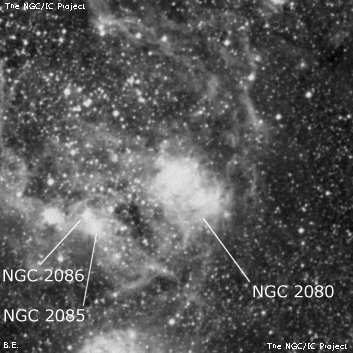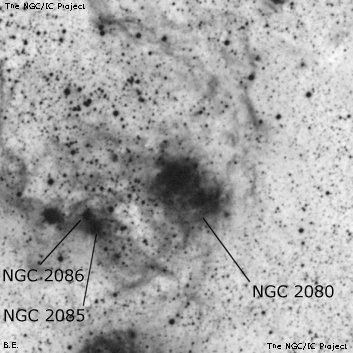NGC/IC Project Restoration Effort
(This is a very very beta version)
NGC2080


Basic Information
Location and Magnitude
Right Ascension: 5:39:44.2
Declination: -69:38:44
Constellation: DOR
Visual Magnitude:
Historic Information
Discoverer: Dunlop
Year of discovery: 1826
Discovery aperture: 9.0
Observational
Summary description: B, R, f of D neb
Sub-type: EN
Corwin's Notes
=====
NGC 2080. See NGC 2077.
Steve's Notes
=====
NGC 2080
24" (4/9/08 - Magellan Observatory, Australia): at 200x and UHC filter, this emission nebula is very impressive, appearing as an extremely bright nebulous glow with an irregular shape, ~1.5' diameter, slightly elongated. The brightest section is encased in a larger, fainter nebulous glow that extends mostly to the south. NGC 2077, a bright HII glow, is attached on the SW side with their centers just 1' apart. At 350x the view was fascinating with 3 or 4 "stars" embedded (the brightest one or two appear to be quasi-stellar knots) and NGC 2080 had a curdled texture. A couple of brighter mag 13/14 stars are off the NW side and a number of stars trail off to the east and NE (part of the O-association LH 103). Located 30' SSE of the center of the Tarantula Nebula.
Along with NGC 2085 and 2086, another pair of knots ~3' SE, this group forms LMC-N160. Roughly 6' S is LMC-N159, another stunning group of nebulous glows consisting of NGC 2078, 2079, 2083 and 2084. NGC 2080 is the brightest region in the LMC-N159/160 complex and is nicknamed the "Ghost-Head Nebula" from a 2000 HST image. The two "eyes" of the Ghost (noted as quasi-stellar above) are rare, compact "high excitation blobs" (HEBs) discovered in 1986.



